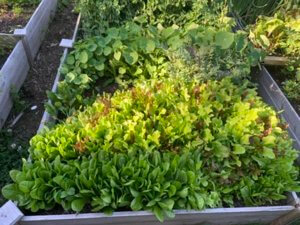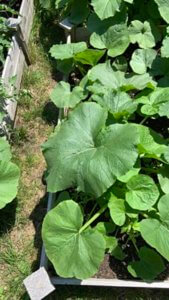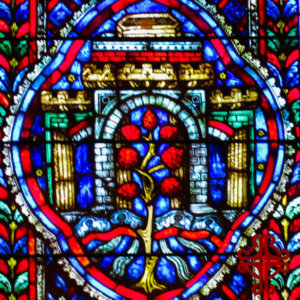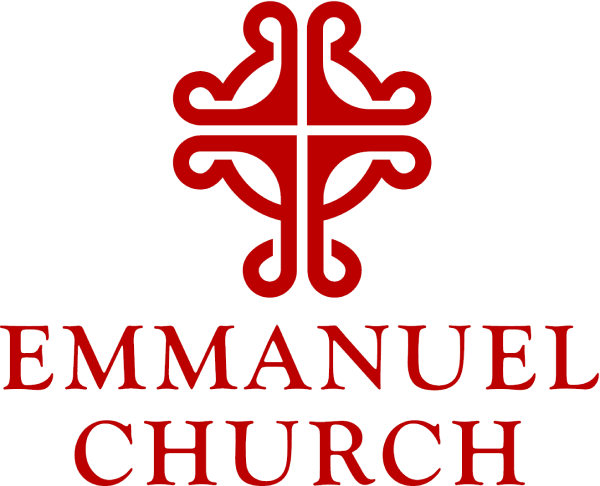
The Mystery in the Garden of Good and Evil
Gracious and forgiving God, out of the depths we call to you. Hear our voice, for there is forgiveness with you, and your word is our hope. Our souls wait for you more than watchmen wait for the morning. We wait for you, for with you there is mercy and plenteous redemption, and you shall redeem us from all our sins. Amen.
 These past weeks of warmer, sunnier days have done wonders for my garden. It’s going gangbusters! Even the heirloom tomatoes — Cherokee Purples — that I planted directly in the still chilled soil from seed are 4 or 5” tall, and it’s still sweater weather in Newport’s planting Zone 7a. The lettuces grow in curly green waves, and the flat leaf parsleys wave their fern-like fronds in the breeze. The sugar snaps are blooming, the rhubarb is ready, and the Egyptian walking onions my sister Carrie gave me last summer are — as promised — on the move, making their way across the back end of my middle raised bed.
These past weeks of warmer, sunnier days have done wonders for my garden. It’s going gangbusters! Even the heirloom tomatoes — Cherokee Purples — that I planted directly in the still chilled soil from seed are 4 or 5” tall, and it’s still sweater weather in Newport’s planting Zone 7a. The lettuces grow in curly green waves, and the flat leaf parsleys wave their fern-like fronds in the breeze. The sugar snaps are blooming, the rhubarb is ready, and the Egyptian walking onions my sister Carrie gave me last summer are — as promised — on the move, making their way across the back end of my middle raised bed.
I’m just hoping that the cucumbers and peppers that were our greatest performers in last summer’s Virus Victory Garden will get a good start, because over the past 10 days or so, something strange has been happening in my garden. I have noticed that there is a new round-leafed plant taking over. There’s not a single bed without at least 3-4 small ones, and in two of the beds, this newcomer shadows the heirloom tomatoes and cucumbers, and I can’t find my zinnia sprouts. I know there are nasturtiums and strawberries in there, but darn if I can find them under this thriving, prolific mystery plant that has now grown like Audrey II in Little Shop of Horrors.
Mystery Plant
 I can’t get it out of my mind. I look at it from the kitchen window. I examine its root system and leaf pattern, and assess its growth every time I pass. I Google it incessantly, trying to figure out what exactly it is — I’m sure it’s some kind of squash. I’m trying to figure out whether I really need as much of it as I have — or really any of it at all.
I can’t get it out of my mind. I look at it from the kitchen window. I examine its root system and leaf pattern, and assess its growth every time I pass. I Google it incessantly, trying to figure out what exactly it is — I’m sure it’s some kind of squash. I’m trying to figure out whether I really need as much of it as I have — or really any of it at all.
I have to wonder if that’s how Eve felt in our Old Testament reading this morning. I know there are some of you who are not computer people would readily agree that my Googling this plant is exactly like Eve consulting the serpent about the one tree she wasn’t supposed to touch.
Adam and Eve
We didn’t read this part of the story today, but remember that God had given Adam and Eve the responsibility of naming and caring for all of the animals and plants in the Garden. Our English translations of the Book of Genesis use the word “dominion” for the original Hebrew word for this special care. But the idea of the original Hebrew word is really more like stewardship than the control and ownership that dominion implies. God had given Adam and Eve the responsibility of caring for the Garden — tending, nurturing, and helping it thrive.
As a gardener — and as a human being — I can really understand Eve’s preoccupation with the mysterious tree at the center of the garden. Eve — and all of us — are just going to be concerned about the world around us. It’s our very humanity that makes it so.
 We’ve all learned from our earliest days in the church that when Adam and Eve’s ate from the tree of knowledge of good and evil, they sinned in a way that makes our sins today unavoidable. It helps to understand sin if we remember that the real pain of sin is separation from God, rather than some specific activity that human beings have decided God doesn’t want us to engage in — like drinking, dancing, or gambling, for example.
We’ve all learned from our earliest days in the church that when Adam and Eve’s ate from the tree of knowledge of good and evil, they sinned in a way that makes our sins today unavoidable. It helps to understand sin if we remember that the real pain of sin is separation from God, rather than some specific activity that human beings have decided God doesn’t want us to engage in — like drinking, dancing, or gambling, for example.
What’s important in the story of Adam and Eve in the Garden is the natural, ongoing movement of human beings toward God. Just as we naturally — maybe even through our loving care for the world — get preoccupied with the wrong things and are separated from God, in most cases, we are naturally propelled back to God. As the psalmist says, we call out from the depths, knowing and waiting for God’s mercy with the focus and attention of the watchman waiting for the morning.
Jewish Studies professor Malka Simkovich writes that neither the Apostle Paul nor medieval sources read the story of Adam and Eve’s fall literally. Maybe it didn’t matter to them whether the story of Adam and Eve really happened. They were focused on the transcendent theological message of the story.
Becoming
Theology and ethics professor David Grumett suggests that humans exist in a process of becoming, rather than being made perfect from the start. That’s why Grumett suggests that Adam and Eve are best understood as images of sin — separation from God — and not as our biological ancestors. Preacher, author, and religion professor Barbara Brown Taylor writes in her book Speaking of Sin that sin is our only hope, because the recognition that something is wrong is the first step toward setting it right again. There is no help for those who don’t think they need help. And there is no healing for those who insist nothing is broken.
Roman Catholic doctrine has long taught the idea of Adam and Eve’s fortunate fall — felix culpa in Latin. The idea is that if Eve’s curiosity about the tree in the middle of the Garden hadn’t absolutely hijacked her attention, she and Adam wouldn’t have eaten the forbidden fruit, God would not have expelled them from the Garden, they wouldn’t have been in need of redemption, and there would have been no need for Jesus to come as God incarnate to redeem us and restore us to our closeness to God.
In other words, the fall itself created the opportunity for redemption and restoration to God. Sin is the essence of our created humanity. But as we repeat in our Baptismal Covenant, Will you persevere in revisiting evil, and whenever you fall into sin, repent and return to the Lord? I will with God’s help. Amen
